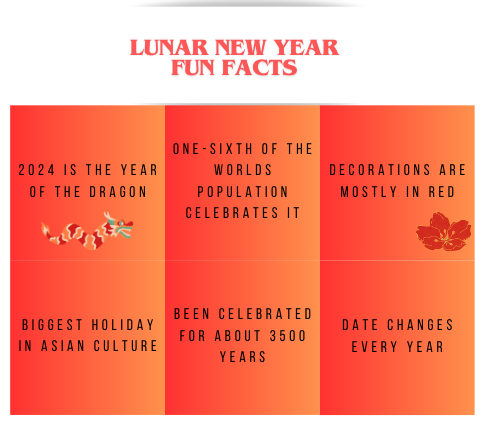Fireworks go off and lanterns are lit as 2 billion people participate in celebrations to say farewell to the old year and usher in the new one on the lunar calendar starting on Feb. 10. Lunar New Year is a time to feast and see family.
“When I was in Korea, my family would come and we would light up the lanterns and let it up in the sky.” sophomore Elizabeth Hansen said.
Lunar New Year is the 15-day celebration and it is also known as the Spring Festival in other parts of the world. Lunar New Year is celebrated widely in China, South Korea and Vietnam, as well as in countries with a large Chinese population, like the United States. Those who celebrate view it as a time to reconnect with their immediate and extended family.
“The night before Lunar New Year, I usually eat a big dinner with my family,” sophomore Carrie Chia said. “During the pandemic, I stayed with my family for the whole two week celebration.”
Every year, those who celebrate the holiday use the beginning of a new lunar calendar to mark the start of spring. The festival is deeply rooted in cultural and historical traditions, with each day holding special significance. For example, the final day of Lunar New Year is called the Lantern Festival, where individuals indulge in tangyuan—a traditional rice ball dessert—and children wander around the neighborhood during the evening, holding lanterns to symbolize the conclusion of the festivities.
“It might be different than other family traditions [for the Lunar New Year], but our family sits together and we talk about our wishes and goals for the next year,” Hansen said.
Some common traditions are decorating their windows and doors with red paper cut-outs that say “Happy New Year” or “Good fortune.” People shop for holiday foods in the open-air market and clean their homes as a ritual to get rid of any old or expired items in the home.
“We clean up before Lunar New Year because it’s said that you get rid of the bad omen and everything bad that happened in the previous year to bring in more prosperity,” Chia said.
The Lunar New Year reunion dinner is one of the highlights of this holiday. It is a feast with symbolic dishes like a whole fish that symbolizes abundance and good fortune or spring rolls that symbolize bars of gold and bring wealth and prosperity for the upcoming year.
“We make kimchi dumplings in our family because we really like kimchi,” Hansen said. “We also make tteoki, which is rice cake and there are many varieties.”
Hongbao, the Chinese word meaning “red bag” or “red envelope,” is one of the most well- known aspects of Lunar New Year. These red paper bags filled with money are often given by the elders of the family. Hongbao has been around since at least the tenth century, with a special place in Asian culture due to its ritual significance.
“Because I’m Korean, we go to the elders in our family and they give us money in envelopes with words of encouragement written on them, then give us advice for going into the next year,” freshman Analise Lee said.









